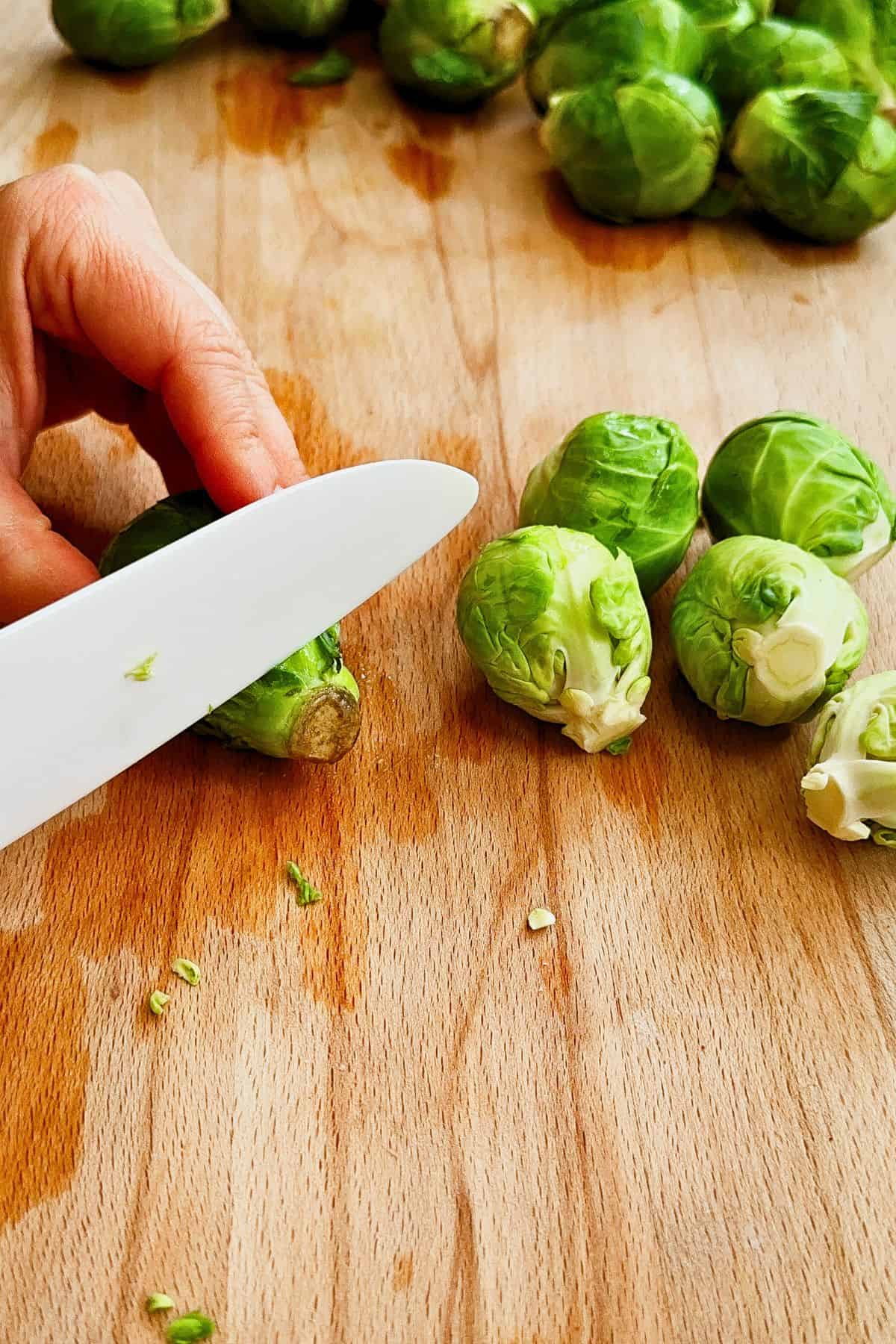If you're new to Brussels sprouts or have had the unfortunate experience of soggy, overcooked sprouts as a kid, fear not!
This comprehensive guide to Brussels sprouts will help you navigate the world of these little cabbages, from selecting the perfect ones to mastering the art of preparation and cutting.
It's a game-changer that can may be the first step to turning your relationship with Brussels sprouts from loathing to loving in no time.

Jump to:
A Quick Note About Brussels Sprouts
Brussels sprouts, those petite, cabbage-like orbs, are a versatile and nutritious vegetable.
Cultivated for centuries, these miniature green gems boast a rich history that dates back to ancient Rome. Originating in the Mediterranean region, Brussels sprouts are now grown in various parts of the world, thriving in cooler climates.
Their distinct taste and versatility make them a favorite ingredient in many dishes. With a growing season that spans from late summer through early winter, Brussels sprouts offer a flavorful addition to seasonal menus and their potential for diverse preparation methods, from roasting to sautéing.
Where to Buy and How to Store
You can usually find Brussels sprouts in the produce section of your local grocery store, especially during their season, which runs from late summer to early winter. They are also available year-round in the freezer section.
Farmers' markets are also a prime spot to score some locally sourced Brussels sprouts for an extra fresh kick.
When you bring them home, they should be placed in the refrigerator. Store them unwashed in a plastic bag or airtight container, and they should be kept for about a week.
How to Select the Perfect Sprouts
- Size and Firmness: Choose small to medium-sized Brussels sprouts that feel firm. Avoid excessively large or soft ones, as they may be overripe and less flavorful.
- Vibrant Green Color: Opt for sprouts with vibrant, bright green leaves. Avoid any that appear yellowed, browned, or have dark spots, as these can indicate age or spoilage.
- Compactness: Choose Brussels sprouts with tightly packed leaves. Loose or open leaves can be a sign of age or improper storage.
- Stem End: Examine the stem end of the sprouts. It should look fresh and moist, without signs of drying out or mold.
- No Odor: Smell the Brussels sprouts; they should have a fresh, earthy scent. If they emit a strong or unpleasant odor, it's best to avoid them.
- Seasonality: Brussels sprouts are at their peak during the late summer, fall, and early winter months. Buying them in season generally ensures better quality and flavor.
- Local and Organic Options: If available, choose locally grown or organic Brussels sprouts, which may offer superior taste and freshness.
- Uniformity: If you need whole Brussels sprouts for a recipe where even cooking is crucial, try to select sprouts that are similar in size, so they cook evenly.
Preparing and Cutting Brussels Sprouts
Preparing Brussels sprouts is a simple yet crucial step in creating delicious dishes.

Step 1: Rinse the sprouts under cold water to remove any dirt or debris.

Step 2: Trim a small slice off the stem end.

Step 3: Peel away any loose or damaged outer leaves. This ensures that you're working with the freshest parts and promotes even cooking.
Cutting the Sprouts

Step 4: Carefully cut each Brussels sprout in half vertically, from top to bottom. This results in two even halves. If you prefer smaller pieces, continue to quarter them long ways, through the core. This keeps the leaves together. This is how I use them in Sheet Pan Gnocchi with Maple-Dijon Glaze.

Step 5: For shredding Brussels sprouts, continue thinly slicing each sprout crosswise. Continue slicing until you reach the stem end. You'll end up with thin ribbons of Brussels sprouts.
Note: Alternatively, you can use a mandoline slicer or food processor to shred Brussels sprouts quickly and uniformly.
Top Tips
- Use a Sharp Knife: Ensure your knife is sharp. A dull knife can make cutting more challenging and less precise. A sharp knife will give you clean, even cuts.
- Shredding Tip: When shredding Brussels sprouts, hold them securely with your fingers slightly curled under to protect them from the knife blade. Make slow, deliberate cuts to create thin ribbons.
- Consistent Sizing: Aim for consistent sizing, especially if you're cooking Brussels sprouts together. This ensures even cooking.
- Use a Mandoline (Optional): If you need very thin slices or shreds, consider using a mandoline slicer for precise and uniform results. Always use the handguard provided for safety. Alternatively, use a food processor with a shredding attachment.
Now, What Do I Do With Them

Cooking Brussels Sprouts
With versatile cooking techniques, Brussels sprouts can suit various dishes. Roast for caramelized sweetness, steam for vibrant color and tenderness, boil for quickness, or sauté for savory crispness. Roasting and sautéing result in the tastiest sprouts. Serve them drizzled with Blood Orange Vinaigrette or an Easy Lemon Vinaigrette for a delicious, quick side dish.
Here are some more Brussels sprouts recipes and inspiration:














Comments
No Comments